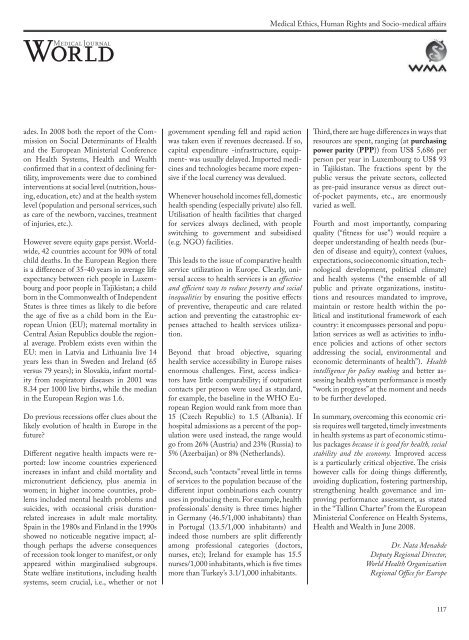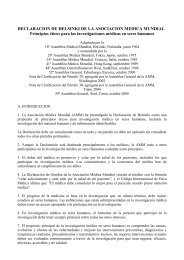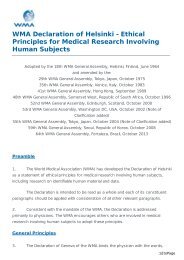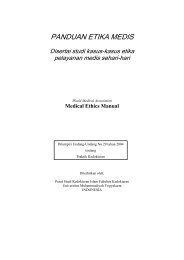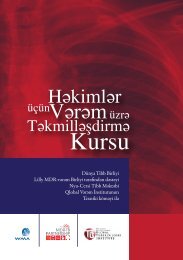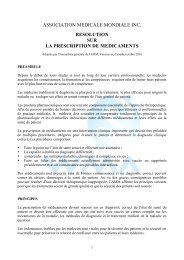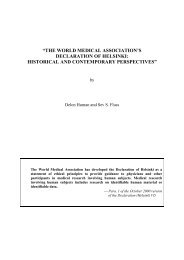wma 7-2.indd - World Medical Association
wma 7-2.indd - World Medical Association
wma 7-2.indd - World Medical Association
Create successful ePaper yourself
Turn your PDF publications into a flip-book with our unique Google optimized e-Paper software.
<strong>Medical</strong> Ethics, Human Rights and Socio-medical affairs<br />
ades. In 2008 both the report of the Commission<br />
on Social Determinants of Health<br />
and the European Ministerial Conference<br />
on Health Systems, Health and Wealth<br />
confirmed that in a context of declining fertility,<br />
improvements were due to combined<br />
interventions at social level (nutrition, housing,<br />
education, etc) and at the health system<br />
level (population and personal services, such<br />
as care of the newborn, vaccines, treatment<br />
of injuries, etc.).<br />
However severe equity gaps persist. <strong>World</strong>wide,<br />
42 countries account for 90% of total<br />
child deaths. In the European Region there<br />
is a difference of 35-40 years in average life<br />
expectancy between rich people in Luxembourg<br />
and poor people in Tajikistan; a child<br />
born in the Commonwealth of Independent<br />
States is three times as likely to die before<br />
the age of five as a child born in the European<br />
Union (EU); maternal mortality in<br />
Central Asian Republics double the regional<br />
average. Problem exists even within the<br />
EU: men in Latvia and Lithuania live 14<br />
years less than in Sweden and Ireland (65<br />
versus 79 years); in Slovakia, infant mortality<br />
from respiratory diseases in 2001 was<br />
8.34 per 1000 live births, while the median<br />
in the European Region was 1.6.<br />
Do previous recessions offer clues about the<br />
likely evolution of health in Europe in the<br />
future?<br />
Different negative health impacts were reported:<br />
low income countries experienced<br />
increases in infant and child mortality and<br />
micronutrient deficiency, plus anemia in<br />
women; in higher income countries, problems<br />
included mental health problems and<br />
suicides, with occasional crisis durationrelated<br />
increases in adult male mortality.<br />
Spain in the 1980s and Finland in the 1990s<br />
showed no noticeable negative impact; although<br />
perhaps the adverse consequences<br />
of recession took longer to manifest, or only<br />
appeared within marginalised subgroups.<br />
State welfare institutions, including health<br />
systems, seem crucial, i.e., whether or not<br />
government spending fell and rapid action<br />
was taken even if revenues decreased. If so,<br />
capital expenditure -infrastructure, equipment-<br />
was usually delayed. Imported medicines<br />
and technologies became more expensive<br />
if the local currency was devalued.<br />
Whenever household incomes fell, domestic<br />
health spending (especially private) also fell.<br />
Utilisation of health facilities that charged<br />
for services always declined, with people<br />
switching to government and subsidised<br />
(e.g. NGO) facilities.<br />
This leads to the issue of comparative health<br />
service utilization in Europe. Clearly, universal<br />
access to health services is an effective<br />
and efficient way to reduce poverty and social<br />
inequalities by ensuring the positive effects<br />
of preventive, therapeutic and care related<br />
action and preventing the catastrophic expenses<br />
attached to health services utilization.<br />
Beyond that broad objective, squaring<br />
health service accessibility in Europe raises<br />
enormous challenges. First, access indicators<br />
have little comparability; if outpatient<br />
contacts per person were used as standard,<br />
for example, the baseline in the WHO European<br />
Region would rank from more than<br />
15 (Czech Republic) to 1.5 (Albania). If<br />
hospital admissions as a percent of the population<br />
were used instead, the range would<br />
go from 26% (Austria) and 23% (Russia) to<br />
5% (Azerbaijan) or 8% (Netherlands).<br />
Second, such “contacts” reveal little in terms<br />
of services to the population because of the<br />
different input combinations each country<br />
uses in producing them. For example, health<br />
professionals’ density is three times higher<br />
in Germany (46.5/1,000 inhabitants) than<br />
in Portugal (13.5/1,000 inhabitants) and<br />
indeed those numbers are split differently<br />
among professional categories (doctors,<br />
nurses, etc); Ireland for example has 15.5<br />
nurses/1,000 inhabitants, which is five times<br />
more than Turkey’s 3.1/1,000 inhabitants.<br />
Third, there are huge differences in ways that<br />
resources are spent, ranging (at purchasing<br />
power parity (PPP)) from US$ 5,686 per<br />
person per year in Luxembourg to US$ 93<br />
in Tajikistan. The fractions spent by the<br />
public versus the private sectors, collected<br />
as pre-paid insurance versus as direct outof-pocket<br />
payments, etc., are enormously<br />
varied as well.<br />
Fourth and most importantly, comparing<br />
quality (“fitness for use”) would require a<br />
deeper understanding of health needs (burden<br />
of disease and equity), context (values,<br />
expectations, socioeconomic situation, technological<br />
development, political climate)<br />
and health systems (“the ensemble of all<br />
public and private organizations, institutions<br />
and resources mandated to improve,<br />
maintain or restore health within the political<br />
and institutional framework of each<br />
country: it encompasses personal and population<br />
services as well as activities to influence<br />
policies and actions of other sectors<br />
addressing the social, environmental and<br />
economic determinants of health”). Health<br />
intelligence for policy making and better assessing<br />
health system performance is mostly<br />
“work in progress” at the moment and needs<br />
to be further developed.<br />
In summary, overcoming this economic crisis<br />
requires well targeted, timely investments<br />
in health systems as part of economic stimulus<br />
packages because it is good for health, social<br />
stability and the economy. Improved access<br />
is a particularly critical objective. The crisis<br />
however calls for doing things differently,<br />
avoiding duplication, fostering partnership,<br />
strengthening health governance and improving<br />
performance assessment, as stated<br />
in the “Tallinn Charter” from the European<br />
Ministerial Conference on Health Systems,<br />
Health and Wealth in June 2008.<br />
Dr. Nata Menabde<br />
Deputy Regional Director,<br />
<strong>World</strong> Health Organization<br />
Regional Office for Europe<br />
117


